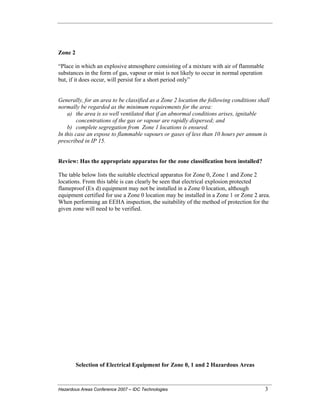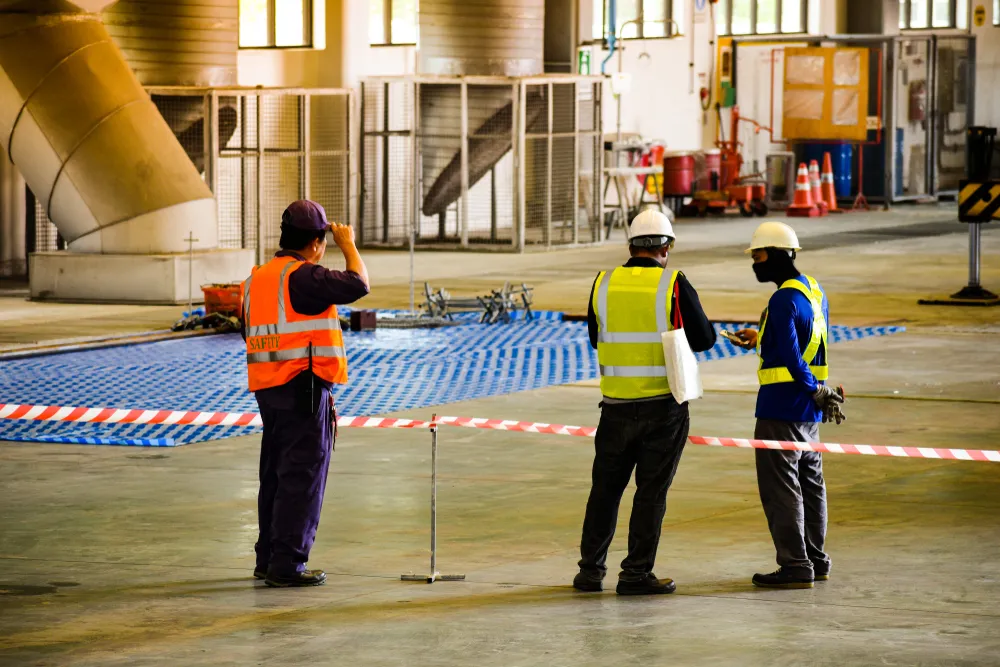About Roar Solutions
About Roar Solutions
Blog Article
Some Ideas on Roar Solutions You Need To Know
Table of ContentsThe 8-Minute Rule for Roar SolutionsRumored Buzz on Roar SolutionsSome Ideas on Roar Solutions You Should Know
In such an atmosphere a fire or explosion is possible when 3 fundamental problems are met. This is commonly described as the "harmful location" or "burning" triangular. In order to shield setups from a potential explosion a method of analysing and identifying a possibly dangerous area is called for. The function of this is to make sure the right option and setup of devices to ultimately avoid an explosion and to guarantee safety of life.
(https://lnk.pblc.app/pub/f49b043987c7b7)
No equipment should be mounted where the surface temperature level of the tools is higher than the ignition temperature of the offered threat. Below are some usual dust unsafe and their minimal ignition temperature level. Coal Dust 380C 225C Polythene 420C (thaws) Methyl Cellulose 420C 320C Starch 460C 435C Flour 490C 340C Sugar 490C 460C Grain Dirt 510C 300C Phenolic Resin 530C > 450C Aluminium 590C > 450C PVC 700C > 450C Soot 810C 570C The probability of the risk being existing in a focus high enough to trigger an ignition will certainly differ from place to location.
In order to classify this risk a setup is divided into areas of danger depending upon the quantity of time the unsafe exists. These locations are described as Zones. For gases and vapours and dirts and fibers there are three areas. Zone 0 Area 20 A harmful ambience is very likely to be existing and might exist for lengthy durations of time (> 1000 hours per year) or also constantly Area 1 Zone 21 A dangerous ambience is possible yet not likely to be present for long durations of time (> 10 450 C [842 F] A classification of T6 means the minimum ignition temperature level is > 85 C [185 F] Unsafe area electrical tools perhaps designed for usage in greater ambient temperature levels. This would showed on the score plate e.g. EExe II C T3 Ta + 60C( This means at 60C ambient T3 will certainly not be surpassed) T1 T1, T2, T3, T4, T5, T6 T2 T2, T3, T4, T5, T6 T3 T3, T4, T5, T6 T4 T4, T5, T6 T5 T5, T6 T6 T6 A T Course score of T1 means the optimum surface temperature level generated by the tool at 40 C is 450 C. Assuming the connected T Class and Temperature level rating for the devices are suitable for the location, you can always utilize an instrument with a much more rigid Division rating than needed for the area. There isn't a clear solution to this question. It really does rely on the sort of devices and what repair work require to be performed. Equipment with details test treatments that can not be performed in the field in order to achieve/maintain 3rd party ranking. Need to come back to the factory if it is prior to the equipment's solution. Area Fixing By Authorised Employee: Complex screening may not be needed nevertheless certain procedures might need to be followed in order for the devices to preserve its 3rd party rating. Authorised workers have to be employed to perform the work correctly Repair service have to be a like for like replacement. New component should be taken into consideration as a straight substitute calling for no unique screening of the tools after the repair is complete. Each tool with a harmful ranking need to be reviewed individually. These are outlined at a high level below, however, for more detailed information, please refer directly to the guidelines.
5 Easy Facts About Roar Solutions Shown
The equipment register is a thorough data source of devices documents that consists of a minimum set of fields to recognize each product's area, technical parameters, Ex lover category, age, and environmental information. This info is essential for monitoring and handling the tools successfully within unsafe locations. In contrast, for routine or RBI tasting assessments, the quality will be a mix of In-depth and Close inspections. The ratio of Thorough to Close assessments will certainly be identified by the Tools Threat, which is evaluated based upon ignition threat (the probability of a source of ignition versus the likelihood of a combustible atmosphere )and the dangerous location category
( Area 0, 1, or 2). This variant will also influence the resourcing demands for job preparation. As soon as Whole lots are specified, you can develop sampling strategies based upon the sample size of each Great deal, which describes the variety of arbitrary tools items to be examined. To figure out the needed sample size, two elements require to be assessed: the dimension of the Whole lot and the group of assessment, which suggests the degree of initiative that need to be used( lowered, regular, or raised )to the inspection of the Lot. By combining the category of inspection with the Lot size, you can after that develop the ideal rejection criteria for a sample, implying the permitted variety of faulty things located within that example. For more details on this process, please refer to the Energy Institute Standards. The IEC 60079 basic advises that the optimum period between assessments must find not surpass 3 years. EEHA assessments will also be conducted beyond RBI projects as component of arranged maintenance and equipment overhauls or repairs. These inspections can be attributed toward the RBI example sizes within the impacted Lots. EEHA examinations are carried out to determine mistakes in electric equipment. A heavy scoring system is crucial, as a solitary piece of tools may have numerous faults, each with differing levels of ignition threat. If the consolidated rating of both assessments is less than two times the fault rating, the Lot is regarded appropriate. If the Lot is still taken into consideration inappropriate, it should undergo a complete assessment or justification, which might trigger more stringent evaluation methods. Accepted Great deal: The sources of any type of mistakes are determined. If an usual failing mode is discovered, added equipment might call for maintenance. Faults are identified by seriousness( Safety and security, Stability, Housekeeping ), making certain that urgent concerns are evaluated and attended to promptly to minimize any effect on security or procedures. The EEHA database must track and tape the lifecycle of mistakes along with the restorative actions taken. Carrying out a durable Risk-Based Inspection( RBI )method is crucial for making sure conformity and safety and security in handling Electric Equipment in Hazardous Locations( EEHA) (eeha courses). Automated Fault Rating and Lifecycle Monitoring: Easily manage faults and track their lifecycle to enhance inspection accuracy. The intro of this assistance for risk-based examination better reinforces Inspectivity's placement as a best-in-class remedy for regulative conformity, as well as for any asset-centric evaluation use instance. If you have an interest in finding out extra, we welcome you to request a demonstration and uncover how our service can transform your EEHA management procedures.
Not known Details About Roar Solutions

In terms of eruptive risk, a dangerous location is an atmosphere in which an eruptive ambience exists (or might be expected to be existing) in amounts that need special precautions for the construction, setup and use equipment. high voltage courses. In this short article we discover the difficulties faced in the office, the threat control steps, and the needed competencies to work safely
These materials can, in certain problems, form explosive ambiences and these can have major and awful consequences. Most of us are acquainted with the fire triangular remove any one of the 3 elements and the fire can not take place, but what does this mean in the context of hazardous locations?
In a lot of circumstances, we can do little concerning the degrees of oxygen in the air, yet we can have significant impact on resources of ignition, for instance electrical equipment. Harmful areas are documented on the hazardous location classification illustration and are recognized on-site by the triangular "EX" sign. Right here, among various other essential details, zones are split right into three types depending on the risk, the probability and period that an explosive ambience will certainly exist; Zone 0 or 20 is considered the most dangerous and Area 2 or 22 is regarded the least.
Report this page